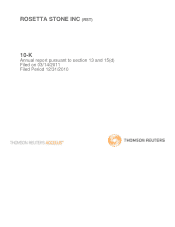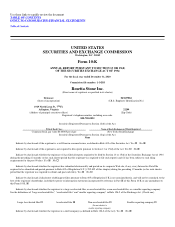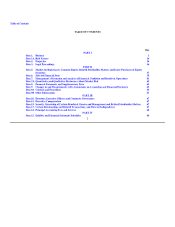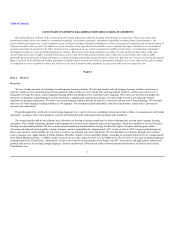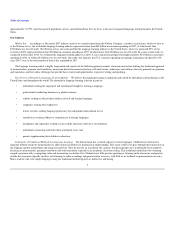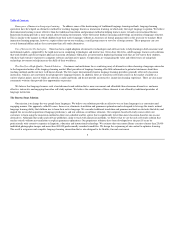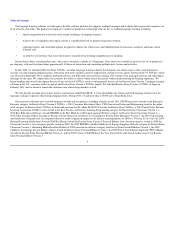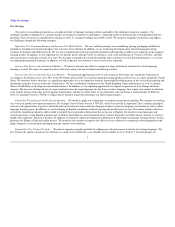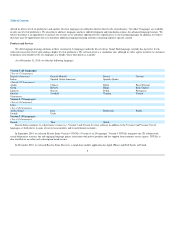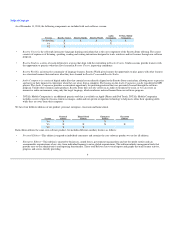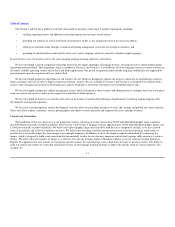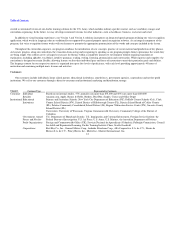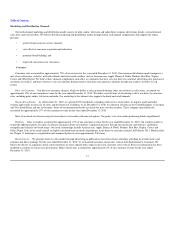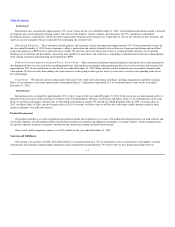Rosetta Stone 2010 Annual Report Download - page 7
Download and view the complete annual report
Please find page 7 of the 2010 Rosetta Stone annual report below. You can navigate through the pages in the report by either clicking on the pages listed below, or by using the keyword search tool below to find specific information within the annual report.
Table of Contents
Emergence of Immersion Language Learning. To address some of the shortcomings of traditional language learning methods, language learning
specialists have developed an alternative method for teaching language known as immersion learning, in which only the target language is spoken. We believe
that immersion learning is more effective than the traditional translation and grammar method in helping learners move towards conversational fluency.
Immersion learning provides a more natural, direct learning environment, where the learner deduces meaning and develops an intuition of language structure.
This is similar to the manner in which children learn their native language, without an awareness of formal grammar rules or the necessity to translate. Most
immersion learning programs, however, require either one-on-one teaching, a small group course or travel to a foreign country. These programs can cost
several thousand dollars and are less convenient than self-study alternatives.
Use of Interactive Technologies. There has been a rapid adoption of interactive technologies and software tools to help learning in both consumer and
institutional markets, supported by the rapid increase in computing technologies and internet use. Given busy lifestyles, adult language learners seek solutions
that work flexibly and do not require physical classroom attendance. Educators are interested in deploying learning tools that are relevant to their students,
who have had extensive exposure to computer software and interactive games. Corporations are recognizing the value and effectiveness of using their
technology investment to help increase the skills of their workforce.
The Need for a High-Quality, Trusted Solution. Consumers and institutions face a confusing array of alternatives when choosing a language course due
to the fragmented nature of the language learning market. Most providers of language learning offer little information to potential customers about their
teaching methods and do not have well known brands. The few major internationally known language learning providers generally offer only classroom
instruction, which is not convenient for all prospective language learners. In addition, there are numerous self-study courses in the market available at a
variety of price points, most of which are offered as audio and books and do not provide an interactive, immersion learning experience. There are also many
community websites that provide free opportunities to practice.
We believe that language learners seek a trusted name-brand solution that is more convenient and affordable than classroom alternatives, and more
effective, interactive and engaging than other self-study options. We believe the combination of these elements is not offered by traditional providers of
language instruction.
The Rosetta Stone Solution
Our mission is to change the way people learn languages. We believe our solutions provide an effective way to learn languages in a convenient and
engaging manner. Our approach, called Dynamic Immersion, eliminates translation and grammar explanation and is designed to leverage the innate, natural
language learning ability that children use to learn their native language. We consider traditional translation and grammar methods as obstacles that delay and
impede the successful acquisition of language proficiency, and our solutions avoid those elements. Our computer-based self-study courses allow our
customers to learn using the immersion method on their own schedule and for a price that is significantly lower than most classroom-based or one-on-one
alternatives. Although other audio and software publishers claim to teach with immersion methods, we believe that we are the only self-study solution that
teaches strictly without any translation or explicit grammar explanations. Our proprietary solutions have been developed over the past 18 years by
professionals with extensive expertise in linguistic, education and instructional technology. We estimate that our content library consists of more than 25,000
individual photographic images and more than 400,000 professionally recorded sound files. We design the sequencing of our content to optimize learning.
The result is a rigorous and complete language learning curriculum that is also designed to be flexible, fun and convenient.
5

